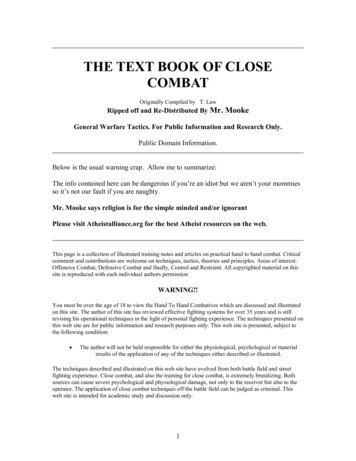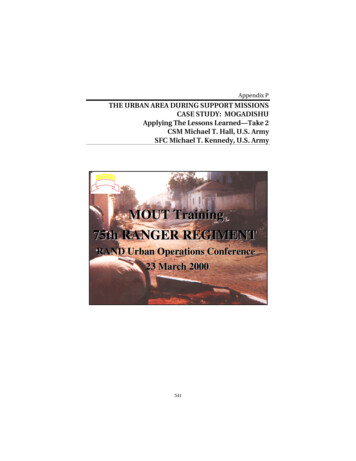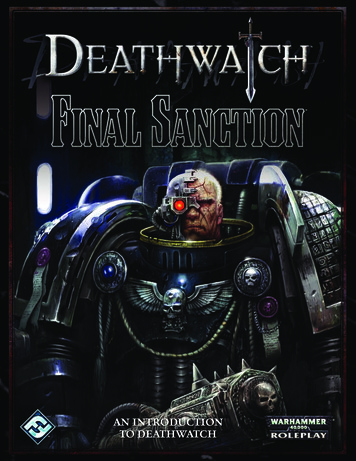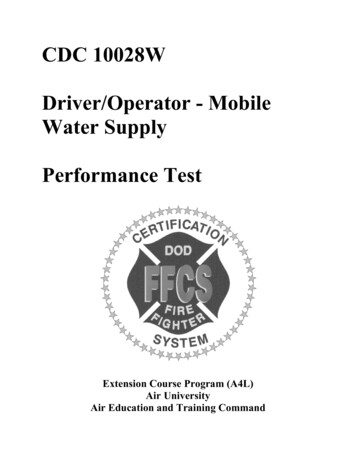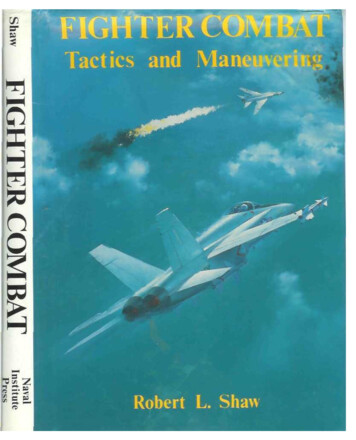
Transcription
Fighter CombatTACTICS AND MANEUVERINGBy Robert L. ShawNaval Institute PressAnnapolis, Maryland
Copyright 1985by the United States Naval InstituteAnnapolis, MarylandFifth printing with corrections, 1987All rights reserved. No part of this bookmay be reproduced without written permissionfrom the publisher.Library of Congress Cataloging-in-Publication DataShaw, Robert L., 1947Fighter combat.Bibliography: p.Includes index.1. Fighter plane combat.I. Title.UG700.S51985358.4' 142ISBN 0-87021-059-9Printed in the United States of America85-21452
ContentsPrefaceixAcknowledgmentsAbbreviations1 Fighter WeaponsAir-to-Air GunsGuided MissilesNotes61xvxvii1312 Basic Fighter ManeuversPursuit Curves62Lag Displacement Rolls67High Yo-Yo71Low Yo-Yo73Lead Turn74Nose-to-Nose and Nose-to-Tail TurnsFlat Scissors82Vertical and Oblique Turns86Rolling Scissors89Defensive Spiral93Notes9762773 One-versus-One Maneuvering, Similar AircraftGuns Only99Rear-Quarter Missiles Only113All-Aspect Missiles Only121Multiple-Weapons Scenarios 127Dissimilar Weapons12898
VICONTENTSDefensive ManeuveringSummary138Notes1381304 One-versus-One Maneuvering, Dissimilar AircraftLow Wing Loading versus High Thrust-to-WeightSingle-Dissimilarity Engagements178Double-Superior and Double-Inferior ConditionsV/STOL and Helicopter Tactical ConsiderationsNotes1941391411821855 Section Tactics, Two-versus-OneBackground195Fighting Wing196Double Attack200Loose Deuce214One-versus-Two Maneuvering223Notes2351956 Section Tactics, Two-versus-TwoHuman Limitations and Task Loading236Two-versus-Two Tactical Doctrine240Summary2632367 Division TacticsBackground266Pre-Engaged Division Maneuvering270Other Division Formations272Engaged Division Maneuvering274Dissimilar-Aircraft Divisions286Notes2892668 Unlimited-Aircraft rsus -Many314Notes3152909 Fighter MissionsThe Fighter Sweep317Point/Area Defense323Strike Escort335Notes34531610 Tactical InterceptsIntercept Terminology347Forward Quarter348Stern Conversion350346
CONTENTSSingle-Side vision Intercepts373Visual Considerations in Air CombatSummary383Vll374Appendix: Fighter Performance387Instantaneous Turn Performance387Energy Maneuverability392Climb Performance403Acceleration Performance405Sustained Turn Performance407Gravity Effects on Turn Performance411Roll Performance412Pitch Performance415Note417Bibliography419Index421
PrefaceAs a young "nugget" naval aviator and aspiring fighter pilot I listenedintently to my instructors, studied hard, did my best to apply what I hadlearned during airborne practice flights . . . and constantly got "hammered." After some period of enduring this humiliation I began askingembarrassing questions of my salty old instructors concerning what Iassumed to be pretty basic tactical concepts. Probably the best answer I gotwas: "Oh, you're supposed to lose at this stage."We wanted a man of the caliber of Boelcke or Mannock or Molders or Malanto explain the unknown and to clear our confused and apprehensive minds;but on this occasion the right senior officer was not present.Air Vice-Marshal J. E. "Johnnie" Johnson, RAFLeading RAF Ace in Europe, WW-II38 VictoriesBeing a hard-to-please sort of guy, I have persisted in my dumb questionsthroughout what seems to be a rather long, but unillustrious, career as afighter pilot. After a relatively short time, however, I came to a startlingconclusion: Nobody seemed to have the answers I was looking for—or ifthey did, they weren't talking. In desperation I searched the literature,thinking that surely, in sixty years of fighter aviation, someone had written the answers down. What I found, mostly, were histories that coveredperiods of aerial combat with broad strokes and a superficial depth, histories whose authors, it often appeared, were working from newspaperaccounts to find information on a subject about which they had littlefirsthand knowledge. There were also some personal histories written bysuccessful (i.e., living) fighter pilots (or derived from interviews with thesepilots), who recounted in detail some of their more interesting combatanecdotes. Aside from being fascinating to another fighter pilot, this latterclass of work quite often actually covered tactics the pilots used and thoseemployed by their opponents. Unfortunately, I soon discovered that these
XPREFACEtactics varied greatly, and, amazingly, that all were sometimes successfulbut disastrous at other times. Although some of the more general conceptsof air combat gleaned from such accounts seemed to be valid in modernwarfare, many of the details were not. Each engagement appeared to be alittle slice out of time which could never be repeated. The aircraft, thepeople, the weapons, the tactics, and the conditions all came together toform a result, and if the engagement had been repeated, even the next day,the outcome easily could have been reversed. Luck and chance seem to bevery strong players in this game. Indeed, one of a fighter pilot's favoriteexpressions is "I'd rather be lucky than good any day."An excellent weapon and luck had been on my side. To be successful the bestfighter pilot needs both.Lt. General Adolph GallandGeneral of the Fighter Arm, Luftwaffe, 1941-45104 VictoriesBut my engineering background had taught me that somewhere thereexists a neat mathematical solution to even the messiest of problems, so Icontinued to search for the basic "truths" that govern these events—or atleast stack the odds one way or the other. Some of these principles do exist,and I hope most of them are included in this text. Much of what you willread here has been derived from personal flight experience, engineeringanalysis of fighter performance data, and "bar talk" with other fighterpilots. (It's amazing how smart a person becomes after a couple of beers.) IfI have stolen anyone's favorite move or pet expression, please accept myapologies. I can assure you the theft was not intentional. It is impossible tobe certain of the exact origins of impressions and opinions formed overmany years. Neither do the tactics described here necessarily reflect thetactical doctrines of the air services of any nation. I have done my best to beas objective as possible on this controversial subject by discussing the prosand cons of several doctrines. No doctrine is perfect, and there will, nodoubt, be "B.S." flags flown by some students and practitioners of thisscience. In this business there is certainly plenty of room for disagreement.Nothing is true in tactics.Commander Randy "Duke" Cunningham, USN5 Victories, Vietnam ConflictIt has been my experience that nations, and even separate air armswithin a given nation, differ in air combat tactics as widely as they do inother areas. In fact, they often disagree even on what constitutes a "tacticaldoctrine." For example, I have found that asking two U.S. pilots for theirtactics in a given situation elicits three different answers. By contrast, it ismy understanding that three Russian fighter pilots will all give the sameanswer. Probably neither of these extremes is optimum. Obviously, if youhave only one tactic, it had better be the correct one; however, even if thisis the case, there are disadvantages to inflexibility. Almost any tactic canbe defeated if it is totally predictable, and dogma stifles innovation. Totalflexibility is not ideal either, as it is difficult for the fighter pilot to becomeproficient if he is constantly changing his style and technique.
PREFACEXl. . . a fighter pilot must be free to propose improvements [in tactics] or he willget himself killed.Commander Randy "Duke" Cunningham, USNA few words might be in order to explain the title of this work, Fighter Combat: Tactics and Maneuvering. The subtitle may sound redundant, but actually many fighter tactics have very little to do with maneuvering. Although all the maneuvers described here have tacticalapplications, some are used more in practice than in actual combat, whereanything more than a level turn feels exotic. Air combat maneuvering(ACM), therefore, has a connotation of "simulated" combat. Fighter tactics are more the "real thing." Both are covered here, and it may not beclear which is which. One clue is to look for phrases such as uncontrolledconditions or unknown environment, which are usually associated withcombat fighter tactics.I didn't turn with enemy pilots as a rule. I might make one turn—to see whatthe situation was—but not often. It was too risky.General John C. MeyerVice-Chief of Staff, USAF26 Victories, WW-II and Korean ConflictAnother term that requires definition is fighter. These days every military airplane jockey, whether he straps on a helo or a trash-haulingtransport, thinks he's flying a fighter. Fighter, in this book, will mean anaircraft whose mission is destroying other airborne aircraft. Much has beenmade of the term fighter-bomber, which describes an aircraft that canperform both air-to-air and air-to-ground missions. Regardless of the designation, as long as that aircraft is assigned to drop things in the dirt, it's atarget, not a fighter. Once it has jettisoned that air-to-mud stuff and goeslooking for trouble, then it's a fighter. As a self-respecting fighter pilot,that's all I'll say on that subject.There are only two types of aircraft—fighters and targets.Major Doyle "Wahoo" Nicholson, USMCFighter PilotThe word tactics also could use some clarification. Too often historiansconfuse this term with the term strategy. Strategy signifies pre-engagement planning for accomplishing rather large-scale goals. For instance, inthe Battle of Britain, the English developed a strategy of using coordinatedfighters and ground-based radar controllers as a defense against Germanbombers. The tactics of the fighters would have included their choice ofattack formations, pre-attack positioning, attack speed, maneuvering toattain a firing position, and engagement/disengagement decision criteria.You will find that most of the literature which purports to deal with fightertactics in actuality covers only strategy. This is probably because information on strategy is much more readily available and is easier for both thewriter and the reader to comprehend, but such works are of little more thanentertainment value to the practicing fighter pilot. Although strategicconcepts are outlined here, the primary purpose of this text is to fill the
XllPREFACEcurrent void of information and understanding associated with nitty-grittyair combat tactics.Bombing is often called "strategic" when we hit the enemy, and "tactical"when he hits us, and it is often difficult to know where one finishes and theother begins.Air Vice-Marshal J. E. "Johnnie" Johnson, RAFThroughout my research in this area, I often have come upon the theorythat air combat has remained essentially unchanged since its advent inWorld War I. To a certain extent this is true. Obviously the laws of physicsand geometry do not change very rapidly, so as long as fighter aircraftremain fixed-wing airplanes with air-breathing engines, there will be somecontinuity in combat tactics. The details of these tactics, however, arechanging constantly. Although the total bag of available tactics probablyhas not been expanded appreciably since World War I, those tactics whichwill be successful vary with each new weapon, aircraft, and combat situation. Military planners often fail to account for this evolution, and consequently they fall into the old trap of training and equipping for the last war.The opposite also has been true, however. Probably the best example ofthis was seen in the 1950s and 1960s, when many fighters were designedand built without guns, since it seemed obvious that the tremendousspeeds of these new aircraft would preclude the close-range turning engagement and that the new "wish-'em-dead" missiles being employedwould make such dogfights unnecessary. The first large-scale combatwith these aircraft and weapons proved this reasoning to be seriouslyflawed. Once again the predicted demise of the dogfight had been "greatlyexaggerated."The most important thing is to have a flexible approach. . . . The truth is noone knows exactly what air fighting will be like in the future. We can't sayanything will stay as it is, but we also can't be certain the future will conformto particular theories, which so often, between the wars, have proved wrong.Brigadier General Robin Olds, USAF16 Victories, WW-II and Vietnam ConflictAlong with tactics and aircraft, the fighter pilot also has changed. Thecrude "packing crates" and weapons of World War I demanded greatphysical dexterity and endurance, excellent marksmanship, good eyesight,and quick reflexes. Successful fighter pilots were, therefore, drawn largelyfrom the ranks of athletes, hunters, sport flyers, horsemen, and race-cardrivers. Although the same attributes and talents are still valuable today,modern fighters and weapons systems have shifted the emphasis somewhat more toward eyesight, manual dexterity, and the ability to think incombat, and away from marksmanship and reflexes. Flying today's fighteraircraft is much like playing a piccolo with each hand, while 3,000-psihydraulic systems have reduced the requirements for great physicalstrength. Paradoxically, the faster speeds of modern fighters have actuallyslowed the pace of turning dogfights because of the resulting slower turnrates. World War I fighters usually could reverse course in less than five
PREFACEXlllseconds, while today's fighters often require about triple that. More timeprovides greater opportunity for the pilot to think and plan during theengagement, and so reduces the reliance on reflex reactions to the opponent's maneuvering. Conversely, longer turn radii and greater weaponsrange have greatly increased the engagement distances between opposingfighters, making excellent eyesight even more critical. Simultaneously,guided weapons and computerized gunsights have reduced marksmanshiprequirements.Aside from the physical qualities, however, aggressiveness, determination, patience, and a cool head seem to have distinguished the successfulfighter pilot throughout the history of aerial combat. Although the purelyphysical attributes normally must be provided by nature, many of themental and psychological qualities can be gained through experience.Particularly in modern air combat, the experience of an older pilot canoutweigh the physical strength and quicker reflexes of youth, as long as theolder pilot can maintain his eyesight, either naturally or by artificialmeans.Great pilots are made not born. . . . A man may possess good eyesight,sensitive hands, and perfect coordination, but the end product is onlyfashioned by steady coaching, much practice, and experience.Air Vice-Marshal J. E. "Johnnie" Johnson, RAFOnly one further point needs to be made at this time; this regarding thenature of air combat. Since so much in this business involves humanaction and reaction, there are few absolutes, so it is unwise to makeunqualified statements about almost anything in the field. Inevitablysomeone will expose a legitimate exception to any proposed rule. Therefore, I adhere to the "never-say-never" philosophy. So, if you should notestatements that include unqualified words such as always or never, pleaseconsider them to be oversights.ACM has many of the qualities of boxing, chess, auto racing, and videogaming, with the ultimate reward for success or failure. It can be sweaty,exhausting, highly cerebral, and terrifying, and it requires great skill andreflexes. Herein lies its challenge and its fascination.Nothing makes a man more aware of his capabilities and of his limitationsthan those moments when he must push aside all the familiar defenses of egoand vanity, and accept reality by staring, with the fear that is normal to a manin combat, into the face of Death.Major Robert S. Johnson, USAAF27 Victories, WW-II
AcknowledgmentsMuch of the credit for this book must go to my wife, Sue, whose patienceand encouragement over the several years of this project have made it allpossible.Thanks to Mrs. Ann Jarrett, who devoted many of her valuable eveningsand weekends to typing the manuscript, and to Greg High who did such afine job preparing the numerous illustrations.I also appreciate the many suggestions and the assistance, explanations,demonstrations, and good-natured ribbing provided by the air crews ofNavy Reserve Fighter Squadron VF-301, based at NAS Miramar, California, with whom I served during my most serious years of research for, andpreparation of, this text. If my work gets by them, I'll be content. Therewill be no tougher audience.The quotes by Adolph Galland fp. 406), Robert S. Johnson (p. 28), DavidMcCampbell (p. 106), John C. Meyer (p. xi), Robin Olds (pp. xii, 52, 67, 236,254), George Freddy, Jr. (pp. 30, 341), and Erich Rudorffer (p. 9) are fromFighter Tactics and Strategy, 1914—1970, by Edward H. Sims. I am gratefulto the author and to Harper and Row, and Aero Publishers, Inc., forallowing me to reproduce this material.I wish to express sincere appreciation for permission to quote from thefollowing works, as well:Bishop, William A., Winged Warfare. 1967 by Doubleday and Company,Inc., Garden City, NY.Boyington, Gregory "Pappy," Baa Baa Black Sheep. 1958, Wilson Press,Fresno, CA.Caidin, Martin, Fork-Tailed Devil: The P-38. 1971, Ballantine Books,NY. With permission of the author.Cunningham, Randy, with Ethell, Jeff, Fox Two: The Story of America'sFirst Ace in Vietnam. 1984, Champlin Fighter Museum, Mesa, AZ.Galland, Adolph, translated by M. Savill,TAe First and the Last. 1954,1982 by Holt Rinehart and Winston, NY. Reprinted by permission ofHolt, Rinehart and Winston, Publishers, and Rosica Colin, Ltd.
XVIACKNOWLEDGMENTSGodfrey, John T., The Look of Eagles. 1958 by Random House, Inc., NY.With permission of the publisher.Hall, Grover C, Jr., 1000 Destroyed. 1978, Aero Publishers, Fallbrook, CA.Higham, Robin, and Siddall, Abigail T., eds., Flying Combat Aircraft ofthe USAAF-USAF. 1975 by the Air Force Historical Foundation,Manhattan, KS.Johnson, J. E., Full Circle. 1964 by J. E. Johnson. By permission ofHutchinson Publishing Group Limited.Johnson, Robert S., with Caidin, Martin, Thunderbolt! 1958, 1959, byMartin Caidin and Robert S. Johnson. With permission of the author.McCudden, James T. B., Flying Fury. 1968 by Stanley Ulanoff. Withpermission of Doubleday and Company, Inc., and Mrs. J. M. Benns.Musashi, Miyamoto, A Book of Five Rings, trans. Victor Harris. 1974,The Overlook Press, Woodstock, NY. With permission of The OverlookPress, Lewis Holloe Road, Woodstock, NY 12498 and Allison and BusbyLtd., London.Rickenbacker, Eddie V., Fighting the Flying Circus. 1965, Doubleday andCompany, Inc., Garden City, NY.Scott, Robert L., Jr., God 7s My Co-Pilot. 1943, 1971, Ballantine Books,NY.Taylor, W. P., and Irvine, F. L., History of the 148th Aero Squadron. 1957by The Air Force Historical Foundation, Manhattan, KS.Toliver, Raymond F., and Constable, Trevor J., Horrido! (Fighter Aces ofthe Luftwaffe/. 1968, 1977, by Raymond F. Toliver and Trevor J. Constable. New York: Bantam Books, 1979.
ircraft artilleryair-to-air missileaerodynamic centerair combat maneuveringairborne intercept controlangle of attackangle off the noseangle off the tailantenna-train anglebasic fighter maneuverbeyond visual rangecombat air patrolcommand, control, and communicationscenter of gravitycontinuous wavedegrees to goelectronic counter-countermeasureselectronic countermeasureselectronic identificationspecific energyelectronic warfarefrequency modulationforward quarteracceleration in gravity unitsGerman Air Forceground-alert interceptorgun-bore lineground-controlled interceptradial accelerationaltitudealtitude-Mach
XV111HUDheads-up displayIADSintegrated air-defense systemINSinertial navigation systemIRinfraredIRCCM infrared counter-countermeasuresIRCMinfrared countermeasuresKFTthousand feetKIASknots indicated airspeedKTASknots true airspeedLCOSlead-computing optical sightL/Dlift-to-drag ratioLOSline of sightMMachMBCmain-beam clutterMCRcritical MachMSLmean sea levelnload factorNMnautical milesPDpulse-DopplerPRFpulse-repetition frequencyPsspecific excess powerQdynamic pressureRAFRoyal Air Force (British)RFCRoyal Flying Corps (British)ROErules of engagementRQrear quarterRTturn radiusRWRradar-warning receiverSAMsurface-to-air missileSLCside-lobe clutterTAAtarget-aspect angleTCAtrack-crossing angleTOFtime of flightTRturn rateT/Wthrust-to-weight ratioUSAAF United States Army Air ForceUSAFUnited States Air ForceUSASUnited States Air ServiceUSMC United States Marine CorpsUSNUnited States NavyUSNRUnited States Navy ReserveVvelocity (true airspeed)Vccorner speedVIDvisual identificationVIFFthrust vector in forward flightVsstall speed at 1 GV/STOL vertical/short-takeoff or -landingWW-IWorld War OneWW-II World War TwoABBREVIATIONS
Fighter CombatTACTICS AND MANEUVERING
1Fighter WeaponsFighter aircraft exist to destroy other aircraft. The airplane itself may beconsidered only a weapons platform designed to bring the weapons systeminto position for firing. Fighter weapons have varied greatly over the years,and each weapon has had unique requirements for successful employment. The requirements might include effective ranges, aiming, relativeposition of fighter and target, or any number of other factors. All of therequirements of a particular weapon must be satisfied simultaneously inorder for the weapon to be used successfully. Meeting these weapons-firingrequirements, while frustrating those of the enemy, must therefore be thegoal of all fighter tactics and maneuvering.Before fighter tactics can be discussed effectively, an understanding ofweapons systems must be developed, since these weapons are the drivingforces behind tactics. This chapter discusses the major classes of weaponswhich have been used by and against fighter aircraft. Included in thediscussion are operating characteristics, operating limitations, and countermeasures associated with these weapons.Air-to-Air GunsThe most important thing in fighting was shooting, next the various tacticsin coming into a fight and last of all flying ability itself.Lt. Colonel W. A. "Billy" Bishop, RAFProbably the leading RAF Ace of WW-I72 VictoriesThe gun is by far the most widely used and important air-to-air weaponever devised. The story of the adaptation of this weapon for aircraft use isvery interesting and has been the subject of several other works, so it willonly be treated in summary fashion here.Aircraft guns may be classified as "fixed" or "flexible." Fixed guns areinstalled in a stationary position relative to the aircraft, usually are forward firing, and are aimed by pointing the entire fighter. Flexible guns,
2FIGHTER WEAPONSalthough fixed to the aircraft, may be aimed up, down, and from side to sideby the operator to cover a certain field of fire, which may be in anydirection relative to the aircraft. Such guns may be manually operated orinstalled in power turrets.Fixed, forward-firing guns have many advantages for small, maneuverable fighters. Their installation is generally lighter and produces less drag,so they have less negative impact on performance. Flexible guns usuallyrequire a dedicated operator in addition to the pilot, which further adds toaircraft size and weight. Maneuvering relative to another aircraft is alsomuch simpler when the opponent can be kept in front of the attacker,which essentially requires a forward field of fire. For these and otherreasons, fixed forward-firing guns have been found to be superior for small,offensive aircraft (fighters), while flexible guns are generally preferred forthe defense of larger, less maneuverable aircraft.By trial and error, fighter armament in World War I progressed frompersonal side arms to flexible machine guns and, eventually, to fixedmachine guns. The standard fighter at the end of this conflict had two.30-cal-class fixed forward-firing machine guns, which often wereequipped with synchronizers to allow fire through the propeller disc.The tremendous progress in aircraft performance during the 1920s and1930s was in large measure the result of the intense interest generated bythe many international speed competitions of those years. Aircraftstructural methods were also revolutionized, as essentially all-metal construction became standard. These developments, as well as the lessons ofWorld War I on the value of firepower, led to significantly increased fighterarmament by the outbreak of World War II.The reasoning behind these developments is fairly clear. First, increasedaircraft performance allowed the weight of greater armament to be carried.Second, designers recognized that the higher closure rates resulting fromfaster aircraft speeds would, in general, lead to shorter firing times, so moredestructive power was necessary in a shorter period of time. Third, metalaircraft, particularly the bombers, were much tougher targets, and increased performance enabled the planes to carry additional armor thatcould be used to protect vital areas of the aircraft (armor for World War Ifighters sometimes was an iron stove lid in the pilot's seat).These developments created a need for greater firepower, which couldbe achieved by more guns, larger projectiles, higher rates of fire, greatermuzzle velocities, or explosive bullets. Some pairs of these factors, however, are related in such a way that neither member of the pair can beincreased independently. Probably the most important of these relationships is that between projectile weight and rate of fire. In general, thegreater the weight of the shell (including bullet, charge, and casing), theslower the rate of fire, owing primarily to the inertia of the heavier movingparts required to handle this ammunition. Obviously, depending on thegun technology at a given time, there should be an optimum balancebetween these two factors. As guns and ammunition are made lighter for agiven projectile weight, the optimum balance shifts toward heavier bul-
FIGHTER WEAPONS6lets. Another factor in this equation involves target vulnerability. Thegreater rate of fire possible with smaller bullets results in an increasedprobability of registering a hit, but greater projectile weight generally leadsto more target damage given that a hit occurs.Some of the armament variations of the combatants during World War IIcan be explained by this factor. For instance, bombers generally are relatively large, poorly maneuvering aircraft that are fairly easy to hit buthard to destroy because of the armoring of vital areas and greater redundancy of important systems. Such a target best may be destroyed by fewernumbers of more destructive projectiles. The opposite may be true ofsmaller, highly maneuverable fighters, which are usually harder to hit.The search for more destructive projectiles led to the development ofthe aircraft cannon. A cannon is essentially a gun that fires explosivebullets. In general, these explosive charges are armed by the firing acceleration of the shell, and they explode on contact with a target. Although someuse was made of single-shot cannon in World War I, truly effective automatic cannon were developed between the wars. These were generally 20to 40-mm weapons and had projectiles significantly larger than those ofthe .30- and .50-cal-class machine guns in common use, with correspondingly lower rates of fire. The cannon themselves were also larger andheavier, leading to further tradeoffs in usable aircraft space and in performance.The many variations and exceptions of aircraft armament used in WorldWar II cannot be discussed in detail here, but some general trends deservemention. The firepower of the earlier fighters was invariably increased inlater versions of the same aircraft, as well as in new fighters introducedduring the war; increased projectile/target specialization also was apparent as the conflict progressed through its various stages. For instance,U.S. fighter designers, primarily concerned with German and Japanesefighter opposition, tended to stay with high rate-of-fire machine guns. Thestandard armament of the more important U.S. fighters (P-51, P-47, F4U,F6F) at war's end was six or eight .50-cal Browning machine guns. Thesewere usually mounted in the wings, where there was more room and norequirement for synchronization, so that the full rate of fire could bedeveloped. German designers generally employed a combination of cowlmounted (often synchronized) and wing guns, and they tended to usecannon for more potency against the heavy bombers that were their primeconcern. Late in the war the Me 262 (jet) and Me 163 (rocket) fighters,primarily used as bomber interceptors, employed four 30-mm cannonand/or 50-mm unguided rockets. Even larger guns were used successfullyby both sides in an air-to-ground role, as were unguided rockets.The advent of wing-mounted guns led to increased problems with bulletdispersion. When all guns were cowl mounted, they were simply boresighted to fire essentially straight ahead (the sight might be aligned toallow for the normal gravity drop of the bullets at a selected range). Butwhen guns were spread out over much of the span of the wings, bulletdispersion became excessive, leaving large holes in the bullet pattern at
4FIGHTER WEAPONSsome firing ranges. The "lethal bullet density" was increased by a methodknown as "harmonization," which generally involved using one of twotechniques."Point harmonization" aligned the outboard guns slightly toward theaircraft centerline so that the bullets met at a point that was assumed to bethe optimum combat firing range (normally 700 to 800 ft). This methodresulted
looking for trouble, then it's a fighter. As a self-respecting fighter pilot, that's all I'll say on that subject. There are only two types of aircraft—fighters and targets. Major Doyle "Wahoo" Nicholson, USMC Fighter Pilot The word tactics also could use some clarification. Too o

